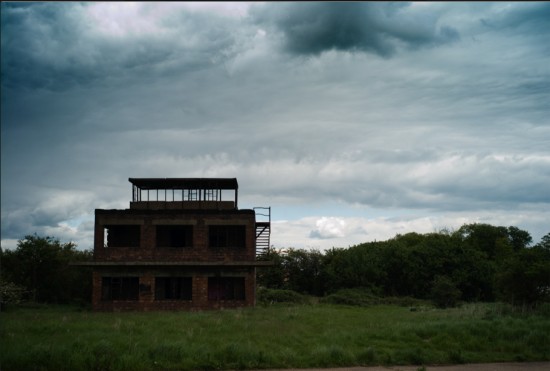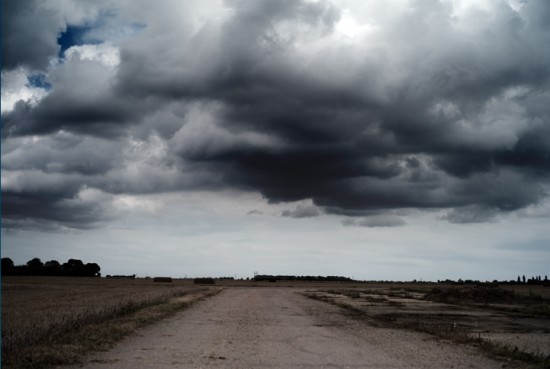
The Lost Airfields Of England by Neil R. Thomson
I have of late begun increasingly to believe in ghosts. This has been a slow process, more a dawning realisation than a single manifestation or moment of epiphany; as imperceptible as the process of ageing itself where one perceives the transition from twenty one to forty one seemingly overnight but also as slowly as a creeping glacier. Twenty years gone in a photographic flash but leaving a memory as full and fragmented as the hard drive of a an old, battered laptop. The ghosts I think I mean are those of history and they are everywhere around us across our landscapes and if you stop to listen you will meet them. Or in my case photograph them.
Of course the most powerful experience gained from growing older is that of the inevitability of loss. Broken relationships and lost friendships sail past. But then sooner or later the big one will happen: the loss of a parent. In my case my father died a few months ago. During the year of his illness, I drove thousands of miles shuttling between London, my parents home in rural East Yorkshire and the Oncology unit where he struggled and fought for a year until laying silently at the end to a clinical narcotic dub-step of infusers and ventilators as life finally deserted him like a ship’s running light disappearing into the fog. These drives were perhaps the only peaceful hours that year that I could enjoy, suspended in time and space by the beauty of travel. There was indeed “No there, there” as Gertrude Stein once put it.

It was during these journeys that an old idea resurfaced. I had long noticed from my speeding car evidence all around of lost airfields, derelict control towers and collapsing hangers. I decided to visit and photograph these sites.
I suppose I have always been obsessed with aviation. My grandfather was an aircraft engineer who apprenticed at Brooklands shortly after the end of the Great War and went on to work for manufacturers like Vickers and Blackburn. As a child he told me an incredibly romantic tale from a night at the height of the Blitz when he and my grandmother were called away from a party to the Supermarine works in Croydon to help pull Spitfires out of the fires lit by German bombs. The image of my grandfather in a dinner suit and my grandmother in a ball gown and the precious, vital machines they helped save which are now such powerful symbols of resistance and victory – almost holy relics of fabric, wire and plexiglass – became shot through with significance.
I built Airfix kits (in fact I still do) and read again and again as a child ‘The Last Enemy’ by Richard Hillary and Guy Gibson’s ‘Enemy Coast Ahead’, still perhaps two of the most powerful personal accounts of the Second World War by writers and pilots who would not see its conclusion. I suppose because of this obsession I was asked to read Pilot Officer Gillespie Magee’s majestic poem ‘High Flight’ one remembrance Sunday as a child in the local Church. Written only a couple of months before he was killed in action in 1941 it remains a mantra for pilots everywhere – a lyrical, almost hallucinogenic poem about one young officer’s love of the process and act of flying. Crucially, nowhere does it reference war or fighting or politics – merely the sheer exhilaration flight, a poem written at a time in history when the air was literally full of fast, brutal and fiery death. His own was to follow very shortly.
Of course I thought about it but bad eyesight and almost certainly an even worse attitude kept me about as far away from RAF Cranwell and officer selection as was possible to be. Instead I embraced the roar of London ending up working at magazines and taking photographs for a so-called living.
However flying and the sense of sublime I always felt around aviation would come to me again, this time through work. I found myself one frozen morning at RAF Kinloss in the Ops room of No.201 Squadron with my cameras. Outside the ancient (50 years old in fact, the Nimrod being based on the Comet, the world’s first commercial jet airliner) low slung airframe of Nimrod XV240 waited in the snow. We took off that night across the flickering oil-fields of the North Sea and up the coast of Scandinavia in weather so bad we were the only thing flying north of Gatwick. On into the endless blackness of the North Atlantic on an ASW sortie to chase the reported spectres of Russian nuclear missile submarines (or ‘boomers’ to use the correct slang) which were rumoured to be transiting off northern Norway on their way to port in Murmansk. At two hundred feet above the waves acting out our own personal Cold War the aircraft performed constant 3G turns, dropping sonorbouys in an effort to pinpoint these leviathans. I imagined them to be like great ancient whales migrating north although with spitting and fizzing missiles slouching in rusting silos in their great humpbacks. My helmet chattered with acronyms. I was mostly confused and very nauseous but I had an epiphany on that flight, a circle in my life had been completed. Eight hours later we returned to Kinloss and I felt in a state of grace.
A month or two later and another embed with the RAF. This time at RAF Boulmer in Northumbria on No. 202 Squadron Search And Rescue. Dressed in full flying and immersion suits with re-breathing life jackets we sat on deckchairs in the spring sun with the ‘Scramble’ phone next to us drinking tea in the shadow of the huge bright yellow Sea King helicopter, engines already warmed, waiting for a job. The significance was not lost on me. Rewind sixty years and young men of the Battle Of Britain found themselves in a similar place but with much, much higher stakes. I felt a very strong karmic wire stretching back to the summer of 1940. The young faces in the cockpit of the helicopter interchangeable with those in fading photographs from seventy years ago. I spent a week burning across the North Sea and the Lake District – “On Squadron” as they say – flying, eating and living with the crews. I really felt that this helicopter and its crews were a higher power in the sky, delivering life and redemption through the roar of jet engines and the great traditions of sacrifice and duty. I made firmer friendships in those brief days than many others that took years. On my way home on the train downloading my photographs I doubt I have ever been so tired but I also doubt I had ever been more content at the end of a photographic assignment. It was genuinely a privilege.
As my father’s malignancy gradually enveloped him I lost pretty much all interest in London and ‘work’ such as it was – taking photos of soon to be forgotten bands and inane personalitys and the hangovers that inevitability ensued from such assignments. I really couldn’t care less about the work but the photographic urge is a strong one and I still needed to capture and project.
My journeys in-between the claustrophobia of a flat on the Seven Sisters Road and the sadness of my mostly empty family home where illness hung in the air like clinical vapour became very precious to me. It was the only time I was ever really alone with the sea, sky and land. I started to visit these places I had noticed on my journeys – the lost Airfields of England – at first stopping off then, later, setting out for days especially to commune with these gone and historic sites. A pilgrimage of sorts I suppose. These missions calmed the growing stress and approaching grief at my own family situation, perhaps like standing on a beach as the sea disappears impossibly before the huge and devastating Tsunami comes. I suppose each exposure from my camera in a way became an act of remembrance. I blew across Lincolnshire visiting the ghosts of Bomber Command and onto Suffolk where the landscape is still shaped by the arrival of the almighty USAAF during the war. Many of the concrete runways broken up after hostilities ended and used to form A roads and Motorways; my battered Citroen sharing the same material under its wheels as once launched P-51 Mustangs and B-17 Flying Fortresses across occupied Europe. I realised that I was hunting semiotic ghosts. Forgive me, but I could swear that on occasions I could hear voices and distant engines somewhere in the wind at these often bleak spots. They were thick with meaning for me. There were sometimes faded memorials at these sites but the real memorials are in the impossible high sky above these places, after all in a burning fuselage over Schwienfurt or a crippled Lancaster over the North Sea there must have taken place a sky burial of sorts.
The project will continue I think. There are hundreds of more derelict airfields out there; my own private photographic acts of remembrance of past events helping me quell my more personal feelings of loss, with the motto of the Royal Air Force which was approved by the King in 1912 ringing in my ears.
“Per Ardua ad Astra.”
“Through Adversity to The Stars”.
Neil Thomson is presenting Phantom Fields and Ghost Squadrons in the Andrew of Arcadia tent at Port Eliot Festival on Saturday 21st July at 6pm.